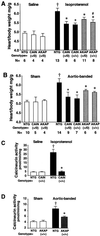Targeted inhibition of calcineurin attenuates cardiac hypertrophy in vivo
- PMID: 11248077
- PMCID: PMC30652
- DOI: 10.1073/pnas.031371998
Targeted inhibition of calcineurin attenuates cardiac hypertrophy in vivo
Abstract
The Ca(2+)-calmodulin-activated Ser/Thr protein phosphatase calcineurin and the downstream transcriptional effectors of calcineurin, nuclear factor of activated T cells, have been implicated in the hypertrophic response of the myocardium. Recently, the calcineurin inhibitory agents cyclosporine A and FK506 have been extensively used to evaluate the importance of this signaling pathway in rodent models of cardiac hypertrophy. However, pharmacologic approaches have rendered equivocal results necessitating more specific or genetic-based inhibitory strategies. In this regard, we have generated Tg mice expressing the calcineurin inhibitory domains of Cain/Cabin-1 and A-kinase anchoring protein 79 specifically in the heart. DeltaCain and DeltaA-kinase-anchoring protein Tg mice demonstrated reduced cardiac calcineurin activity and reduced hypertrophy in response to catecholamine infusion or pressure overload. In a second approach, adenoviral-mediated gene transfer of DeltaCain was performed in the adult rat myocardium to evaluate the effectiveness of an acute intervention and any potential species dependency. DeltaCain adenoviral gene transfer inhibited cardiac calcineurin activity and reduced hypertrophy in response to pressure overload without reducing aortic pressure. These results provide genetic evidence implicating calcineurin as an important mediator of the cardiac hypertrophic response in vivo.
Figures




Comment in
-
Calcineurin inhibition and cardiac hypertrophy: a matter of balance.Proc Natl Acad Sci U S A. 2001 Mar 13;98(6):2947-9. doi: 10.1073/pnas.051033698. Proc Natl Acad Sci U S A. 2001. PMID: 11248009 Free PMC article. Review. No abstract available.
References
-
- Levy D, Garrison R J, Savage D D, Kannel W B, Castelli W P. N Engl J Med. 1990;322:1561–1566. - PubMed
-
- Ho K K, Levy D, Kannel W B, Pinsky J L. J Am Coll Cardiol. 1993;22:6–13. - PubMed
-
- Olson E N, Molkentin J D. Circ Res. 1999;84:623–632. - PubMed
-
- Hunter J J, Chien K R. N Engl J Med. 1999;341:1276–1283. - PubMed
-
- Crabtree G R. Cell. 1999;96:611–614. - PubMed
Publication types
MeSH terms
Substances
Grants and funding
LinkOut - more resources
Full Text Sources
Other Literature Sources
Molecular Biology Databases
Miscellaneous

